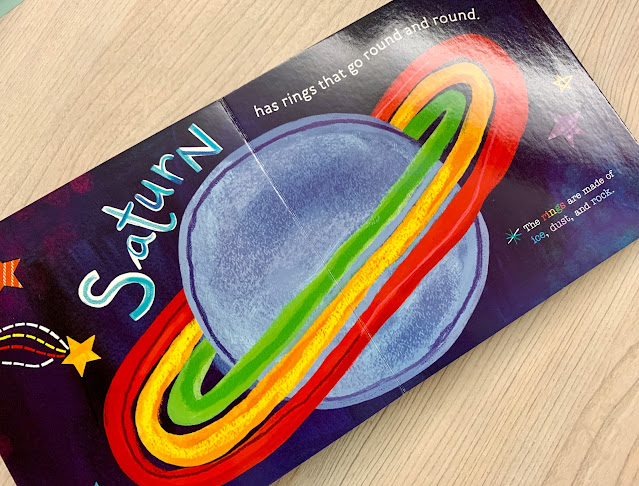嫩薑大概兩歲多的時候,我開始入手科普繪本;「Hello, World」可以算是嫩薑的第一套科普入門:那時候我考慮兩到三歲的認知發展,入手了「Ocean Life」,「Backyard Bugs」,「Solar System」,「Dinosaurs」這四本。
這套書的優點在於它用簡單簡短的句子介紹科普知識,例如Ocean Life裡面,章魚的介紹「An octopus has eight arms.」,螃蟹龍蝦則是「Crabs and lobsters have hard shells on the outside of their bodies」。每頁都還有個小星號✳️,更進階的介紹動物特色,像是鯨魚「Whales breathe air through a blowhole on their head」等等。
「Solar System」是我自己的興趣,想說買來跟嫩薑共讀;共讀過程嫩薑看似沒什麼特別感受;大概一個月之後,再入手Scholastic的Solar System點讀版之後,才發現原來他已經默默吸收這些知識,開啟他對星球,宇宙的興趣。

爸爸的愛心手作星球:嫩薑收到很喜歡,拿來配對遊戲。
📖「Hello, World: Solar System」by Jill McDonald


抬頭看看天空,你看見什麼?
非常實用的句子;任何時刻出門都可以跟孩子說:「Look up at the sky. What do you see?」
👩:「We see stars, the moon.」邊說邊指圖片。「What's this? It looks like a blue ball.」指著最右邊的藍色圖片提問引起小孩興趣試試看。「A ball in the sky?」🤔

你有看到月亮嗎?
✳️太空人已經在月球上留下足跡。
(✳️部分不一定每次都要帶讀到,漸進式加入也可以;我和嫩薑的對話,或是內文英文解釋我也是隨著共讀次數慢慢帶入的。)
月亮是最好帶小孩進入天空世界的媒介;有一陣子常常邀請嫩薑一起抬頭看看天上的月亮。
👩:「Wow, this is the moon. What are these black circles?」,「They are the big holes on the moon. They are craters.」「Why there are craters?」「Big rocks(asteroids) hit the moon, and made craters on the moon. Poor moon!」😂

白天我們看到太陽;太陽是太陽系的中心。我們來認識這些繞著太陽轉的星球吧!
我唸到planet這個字時,我的方式是指一顆星球就唸一次planet這個字,加強字跟圖片的連結。
👩:「How many planets in the solar system?」
👶:「One, two ... nine.」
👩:「Actually there are eight planets in the solar system. The last one(指最遠的那顆Pluto) is not a planet anymore, cause it's too small, smaller than the moon.」
🔆我簡化了Pluto不是planet的原因;對嫩薑現階段來說行星定義超出他的認知發展了。
🔆IAU定義行星為:
The three criteria of the IAU for a full-sized planet are:
(1) It is in orbit around the Sun. (它圍繞著太陽運行)
(2) It has sufficient mass to assume hydrostatic equilibrium (a nearly round shape). (它大到足以讓重力使它成為圓球形)
(3) It has “cleared the neighborhood” around its orbit. (它已清除了其軌道周圍的區域,)
第三點讓Pluto被降為矮行星,因為它的運行軌道和Nepture相交。


Mercury是最靠近太陽的行星;Venus是天空中最亮的行星。
✳️哎唷!小行星和彗星常常撞上Mercury;哇!Venus是太陽系溫度最高的行星。
嫩薑對於「最...」感到興趣,他最先有記憶的就是最亮的Venus,還有最大顆的Jupiter。
👩:「Mercury is the first planet in the solar system. The Sun is just next to Mercury.」「Look! A comet is going to hit Mercury.」這裡可以用很緊張的口吻演繹。
👩:「What colour do you see on Venus?」
👶:「orange? yellow?」
👩:「Yeah! brighter colours, a bit yellowish. 」「Venus is the brightest planet. We can see it in the sky in the evening.」
傍晚在西邊位置,可以看到一顆很亮很亮的星星,基本上它就是Venus。傍晚下課回家我常跟嫩薑說「Look up at the sky. Do you see Venus?」看了很多次之後,他就開始自行腦補說那是Mars,Jupiter等等。😂

我們住的行星稱為Earth;從外太空看,Earth看起來像一顆會選轉的藍色玻璃球。
👩:「Earth is so beautiful, the blue is the ocean, the white is clouds, the green is the land. 」
等共讀幾次之後,我開始問嫩薑每個顏色分別是什麼。

你能指出這個紅色的星球嗎?那是Mars;Jupiter是太陽系最大的行星。
✳️Mars有太陽系最大的火山;Jupiter是太陽系風暴最強的行星。
👩:「Mars has the highest volcanoes in the solar system, called Olympus Mons, boo00m!」
👩:「Can you point to a red spot? 」「It's the Great Red Spot. It's a storm, strong wind, heavy rain.」
有次嫩薑的臉被蚊子叮了一個包,我安慰他說「Your face looks like Jupiter.」隔天去上學就一直跟老師說「Do I look like Jupiter?」😂

Jupiter的光環是一圈一圈的。
✳️光環是由塵埃、冰、和岩石組成的。
👩:「Saturn has beautiful rings. What are the colors of the rings you see here?」
👶:「Red, green, yellow.」
👩:「Next time let's colour our rings.」

Uranus and Neptune都又黑又冷。
✳️冰晶使Uranus呈現藍色,它躺著旋轉;Neptune上的風很大。
側躺著轉可以拿一顆球演示給小孩看;如果不介意用3C,搜尋一下圖片更一目瞭然。
👩:「Neptune has a dark spot. Can you find it?」「It's a storm too, like Jupiter's The Great Red Spot.」「The wind on Neptune can blow you up high into the sky. You can't stand still.」

Pluto是顆矮行星,距離太陽非常遠。
✳️Pluto比月球還要小呢。

有時候我們能看到彗星劃過天空。
✳️當彗星靠近太陽時,它的尾巴會發光。
👩:「Wow, a comet has a glowing tail.」邊指著彗星的尾巴。

👩:「Which planet do you want to go?」
👶:「Uranus.」
👩:「Why?」
👶: 「cause it's blue. I like blue.」「Can you ask Mommy, which planet do you want to go?」
👶:「Which planet do you want to go?」
👩:「Saturn.」「Ask me why?」
👶:「Why?」
👩:「I want to see Saturn's beautiful rings.」
天文知識對幼兒來說比較抽象,我自己會搭配影片看;影片推薦Natioanal Geogrpahic 「Solar System 101」,每個影片大約都只有三到五分鐘,圖片清晰漂亮,可以搭配字幕一起看。
搭配歌曲也很棒;Youtube打「Planet Songs」就有很多選擇了。
分享嫩薑喜歡的其中一首:
每次共讀知識加一點加一點進去;搭配一些教具,具體化知識內容。

網路上看到有人用魔鬼氈做了太陽系的位置圖,也做了一個給嫩薑玩。或是去網路找尋真實圖片護貝後,貼在白板貼給嫩薑看以及讓行星排隊。
推薦DK這個網站,圖片很美,知識量也不錯,還有簡單的小測驗。(點圖片有連結)
如果想要共讀太陽系,可以試試看這本Hello World Solar System,內容用字算是平易近人,也有繽紛插圖,行星的基本知識也都有介紹。
最後再來個著色遊戲吧!(點圖片有連結)
📚 相關閱讀(點擊圖片有連結)
⭐單字表
footprint | 腳印 |
solar | 太陽的 |
planet | 行星 |
asteroid | 小行星 |
comet | 彗星 |
swirl | 旋轉,轉圈 |
volcano | 火山 |
storm | 風暴 |
dust | 塵埃;灰塵 |
ice crystal | 冰晶 |
windy | 颳風的 |
dwarf planet | 矮行星 |
glow | 發光,發熱 |



沒有留言:
張貼留言